Family : Fringillidae

Text © Dr. Gianfranco Colombo

English translation by Mario Beltramini
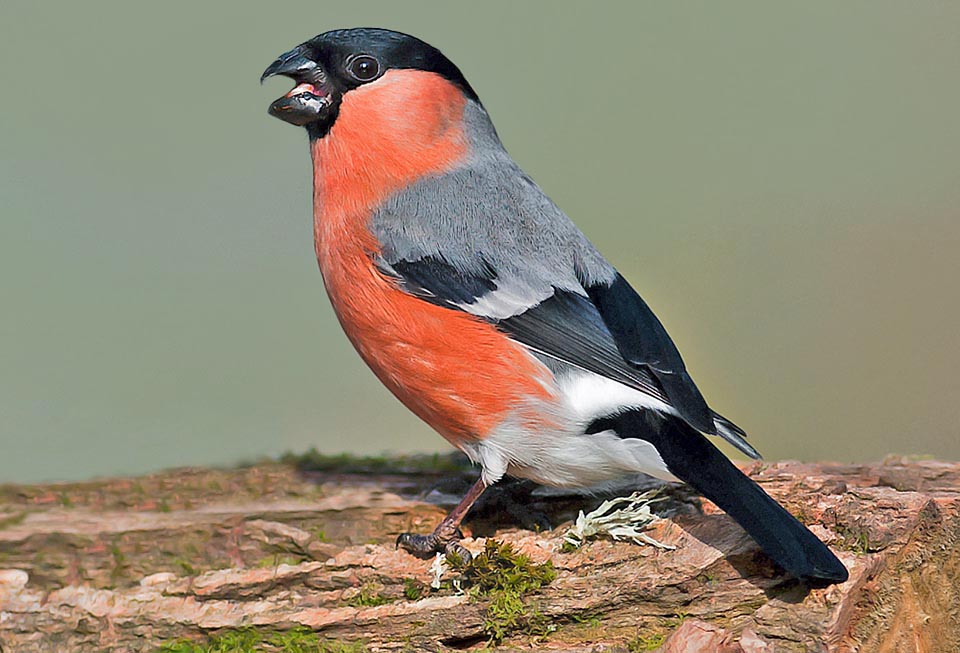
The Ciuffolotto (Pyrrhula pyrrhula) doesn’t owe the name to an evident tuft or to the look of a soft wad but to the whistling song given in various languages and Italianized © Wayne Davies
This splendid small bird is so loved for its beauty as it is hated for its spring vice of eating the buds of the fruit trees. With the very strong beak with which it is equipped, it manages to bite and shred in one go every single bud, spoiling for the current season the possibility of the regrowth of a new shoot.
An unpleasant small job unwelcome by the European fruit growers, more so if caused by small families of these small starving birds who have gone through the sufferings of a not always thriving winter time. A painstaking and systematic work that leaves the affected tree not only without many foliar buds but almost completely eliminating any possibility of fructification. The damage done in the orchards was so serious that for many centuries in England all parishes paid premiums for those killing a bullfinch.
The Bullfinch (Pyrrhula pyrrhula Linnaeus, 1758) belongs to the order of the Passeriformes and to the family of the Fringillidae and is by sure one of the most coloured finches of the Palearctic.
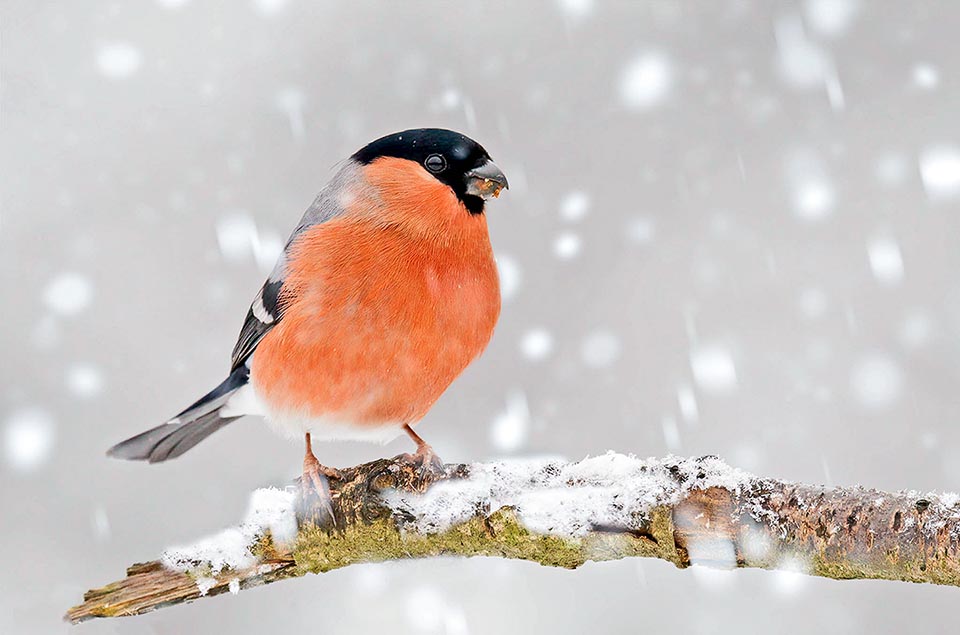
Winter is hard for this strictly vegetarian bird, present in all Europe also in the harshest climates © Steve Dawes
This beauty was the reason also of a certain anger towards this species, in particular of the males who display much more enticing colours than the females and also due to the sweet and gentle character this bird displays when captive, for which it was and still is object of illegal capture.
The genus Pyrrhula has only seven species, all Palearctic but differing visibly due to the different livery, always very varied. The scientific binomial is a tautonym, having the name of the genus equal to that of the species.
The etymology of Pyrrhula comes from the Greek “purrhoulas”, worm eater, and still goes back to denomination given in ancient times by Aristotle, who identified a not better described nice small bird, perhaps the Robin, as a great eater of worms, consideration somewhat distant from reality, as the Bullfinch is almost exclusively vegetarian.
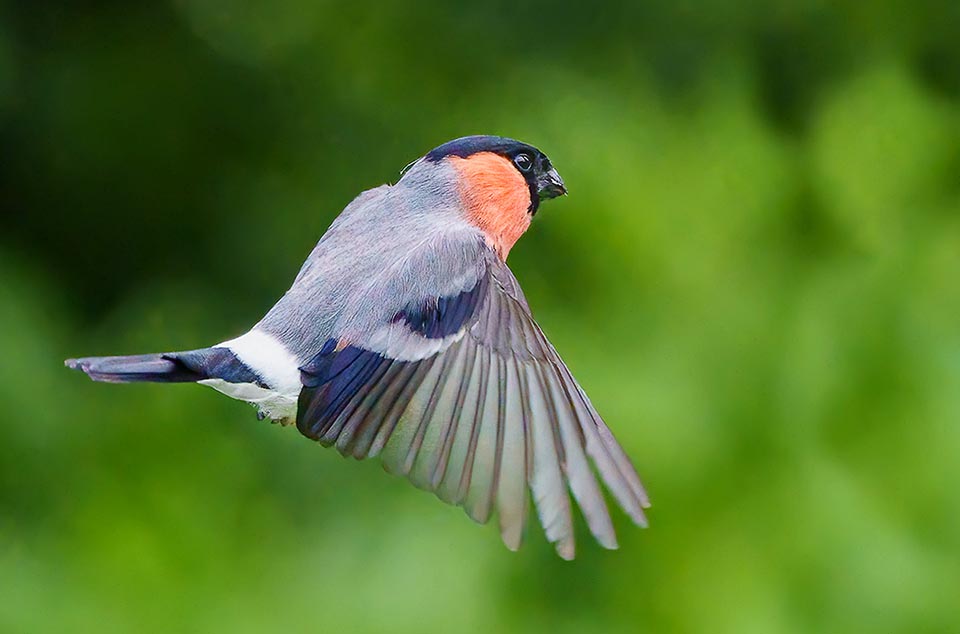
Here it is, hungry, in spring, flying looking for food emphasizing the characteristic candid tail coverts and the white alar bars © Steve Dawes
Others advanced the idea that Linnaeus has instead resumed, more simply, the Greek term “pyrrhos”, red as fire, referring to the shields of the old Greek warriors and, for Bullfinch, to the pinkish colour of its chest.
Callin it vulgarly in Italian Ciuffolotto (tufty), misleads the uninitiated, as lead to imagine it as a bird equipped of a whatever tuft or even that it may look like a nice swollen and morbid soft ball, a common way, however, to appear during the cold winter days, when usually it inflates the feathers getting actually roundish and vaporous like a coloured wool flock.
Conversely, the derivation is of a completely different origin and is often repeated, in many Italian regions, crearer and more evident. In fact, it reflects the mournful cry this bird frequently emits from high up the treetops or from the depth of the forests, a whining “peeu peeu peeu” unrepeatable by any other bird and that have deserved it the name of Zifulòtt, Subiòt, Stuflot, Ciufolot all derived from ciufolare, zufolare, later on Italianized in Ciuffolotto.
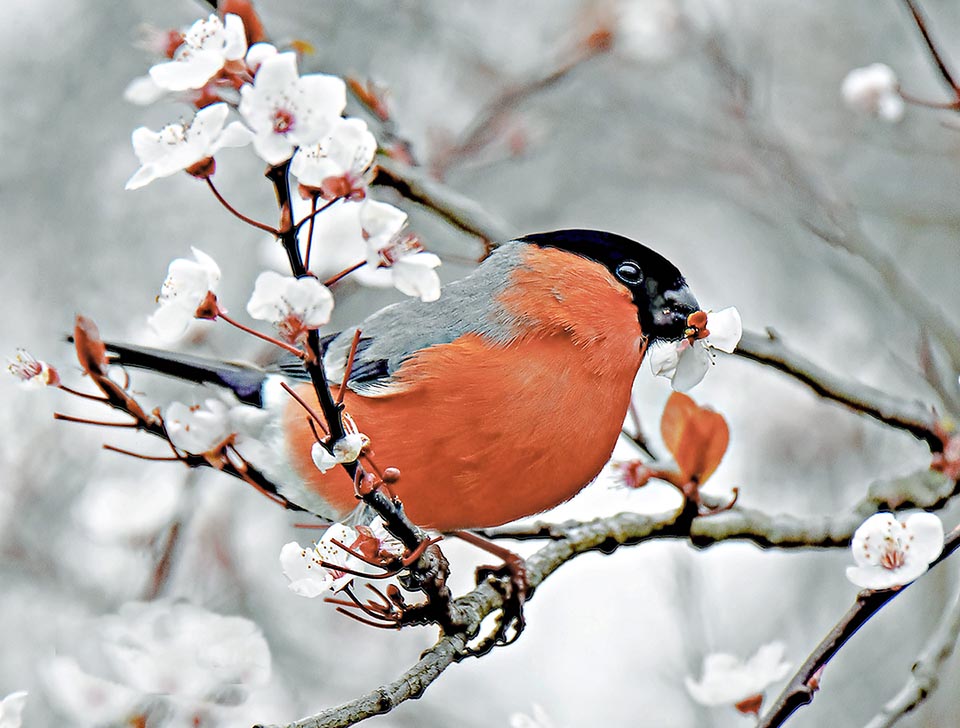
Caught in the act here devours, unscrupulous for farmers harvest, the flowers of the fruit trees © Ramón de Maroto
Some call it Monachino (Little monk) due to the black hood it has on the head.
Instead, in some European countries it is compared to a bull, due to its very robust and bulky neck equipped with a robust beak: in English Bullfinch, in French Bouvreuil pivoine, from the Latin bovariolus = little peony coloured ox. Germans have instead given it a name that indicates a particular characteristic that, as we shall see, makes this bird an incredible simpleton, Gimpel = ninny.
In Spanish it is Camachuelo comùn and in Portuguese Dom-fafe, this last term of a quite articulated origin that renders the idea of how nature in the centuries has crossed boundaries and languages without any limit.
In fact it comes from a deformation of the German names dom = cathedral and pfaffe = cleric, a Dompfaffe then transcribed by the Portuguese, two thousand kilometres far away, as Dom-fafe, rightly because of its particular livery.
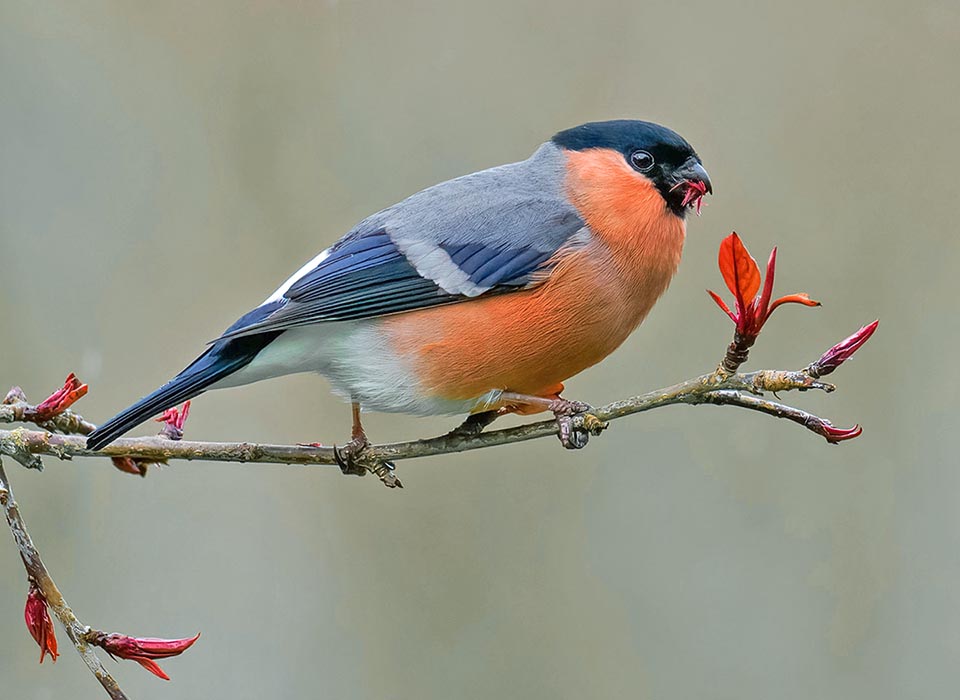
And, not satiated, this colourful male tears off also the buds that will produce the new branches © Iain MacDiarmid
Zoogeography
The Bullfinch is present in all continental Europe, also at very boreal latitudes and, seamlessly, goes further east reaching Kamchatka.
The southern limit goes from the reliefs of Portugal through Spain, Italy and the Balkan peninsula, occupying Anatolia, Caucasus and continuing, north of the Caspian Sea, up to Mongolia, China and Japan.
In the southern quarters its summer presence is more discontinuous and linked to cooler and hilly areas. In fact, it is absent from the Mediterranean islands and at the same latitude it is relegated to the mountain chains, with a gradual reduction up to the disappearance in the nearby plains below.
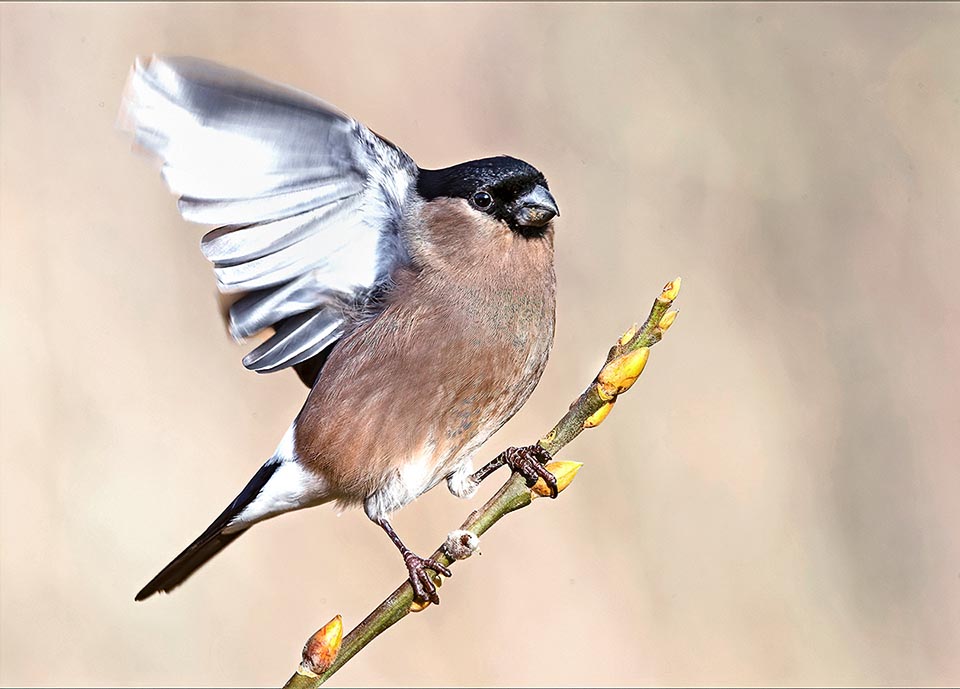
Also the females, with similar livery but the chest amber grey, have the same bad habit and yore the parishes gave prizes for each bullfinch killed © Wayne Street
In a large part of its territory it is considered as a sedentary bird, even if the northernmost populations migrate in winter, gathering in the most southern part of its range, invading environments not frequented during the nidification.
Ecology-Habitat
The Bullfinch is a bird of both deciduous and coniferous big forests, as a matter of fact it loves places that have cool temperatures in summer, humid and also fairly rainy.
The choice altitude is over the 800/1.000 metres with peaks up to 2.000, even if in winter it prefers to abandon the areas that get covered with snow although not exceptionally.
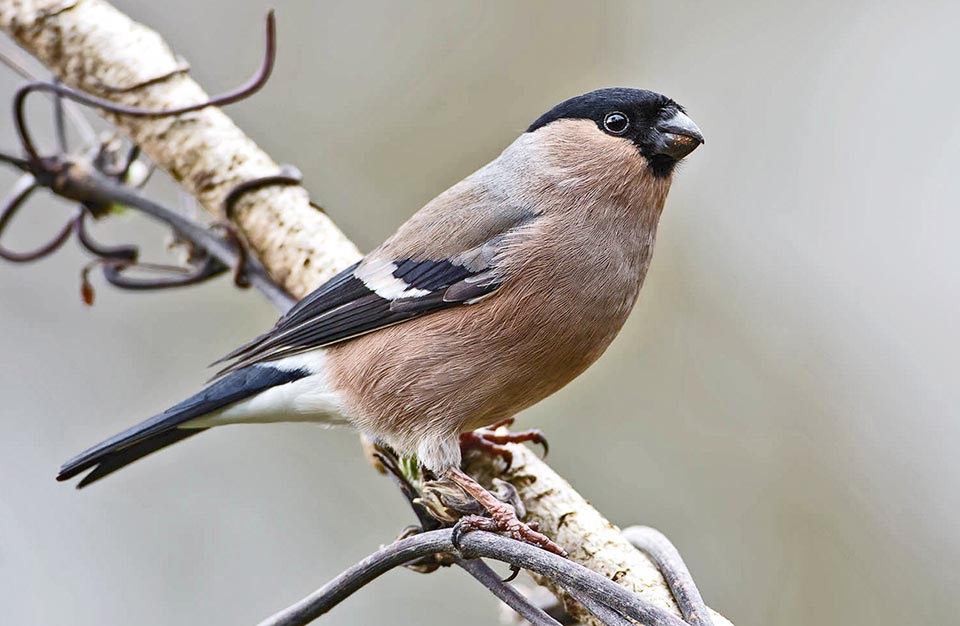
Respect to the partner, even if in its modest livery, also the female flaunts a particular elegance © Kevin Agar
The Bullfinch is in any case a bird who resists very low temperatures and who, willingly, when can get sufficient food, keeps in its nesting territory also during the coldest times of the year.
The North Europe iconography itself represents it nowadays traditionally on the Christmas cards, perched on a sprig of holly full of red berries, rightly to mean that this bird is a constant presence in their environment, also during the harshest winter.
In its habitat cannot miss a tree cover and only by accident, during the winter erratisms, may happen to see it in plains with bushy rows, in gardens and public parks but also in the cities, busy in picking the last remaining berries on the ornamental shrub bushes.
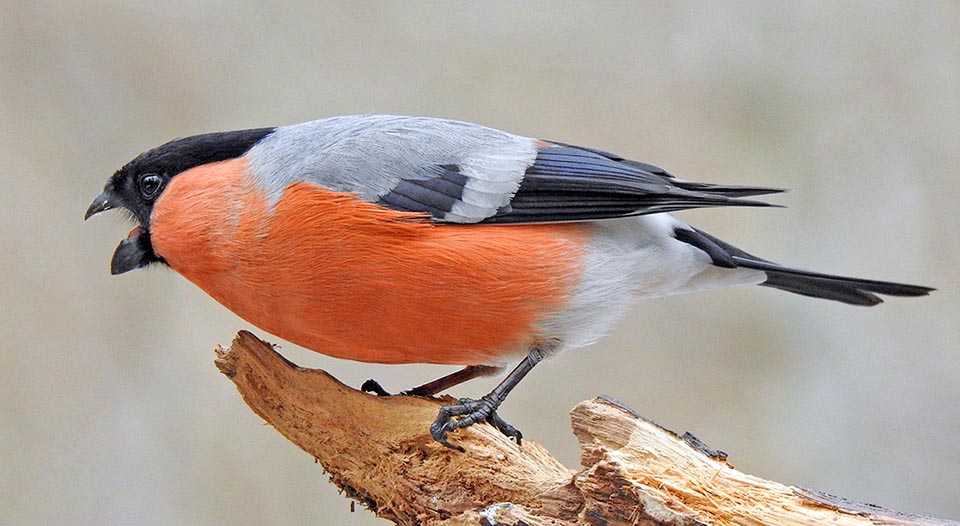
The male fiercely defends its territory while the female is building up the nest © Eero Kiuru
Forests of ashes, alders, beeches and of any other species producing seeds and beechnuts or conifers where to find some pine nuts are its natural environments where the greatest presence of these birds is found.
On the other hand it does not love much to go down to the ground except to catch those few insects necessary for feeding the offspring or for collecting berries fallen down. The man has however partially conditioned this alpine behaviour it has and more and more often we see couples of these birds building their nests at more reduced altitudes, taking advantage of the artificial reforestation and the dense coniferous tree nurseries.
Morphophysiology
As previously mentioned, the Bullfinch is one of the most coloured finches of the Palearctic and perhaps among the very few birds displaying in such an admirable way the pink colour in its plumage.
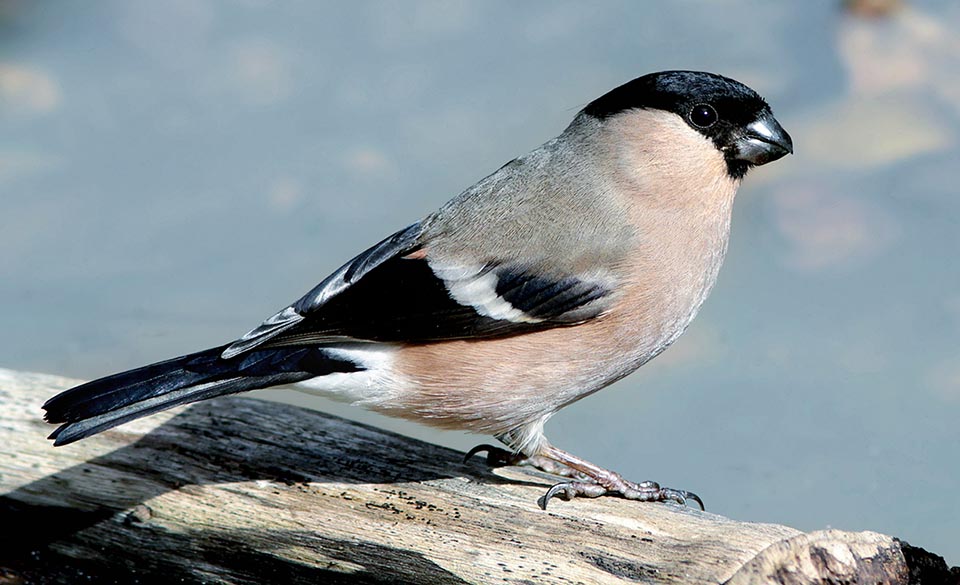
Special case among birds, this female, even in its apparent sweetness, has a rather hard character that prevails in the couple © José Sousa
The male is unmistakable and even incredible if observed by somebody who does not know it.
It might look like an exotic small bird escaped from some nursery yet it is a regular visitor to our country and who frequently visits the winter mangers of our gardens.
The dimensions of this bird are the typical ones of the finches: 15/18 cm of length depending on the subspecies, a wingspan of about 25 cm and a weight of 25 g.
The male has the chest and the cheeks totally of bright pink colour that fades in the undertail becoming ash grey, the same colour covering also the upper part of the rump up to the neck, rightly rejoining the pink colour.
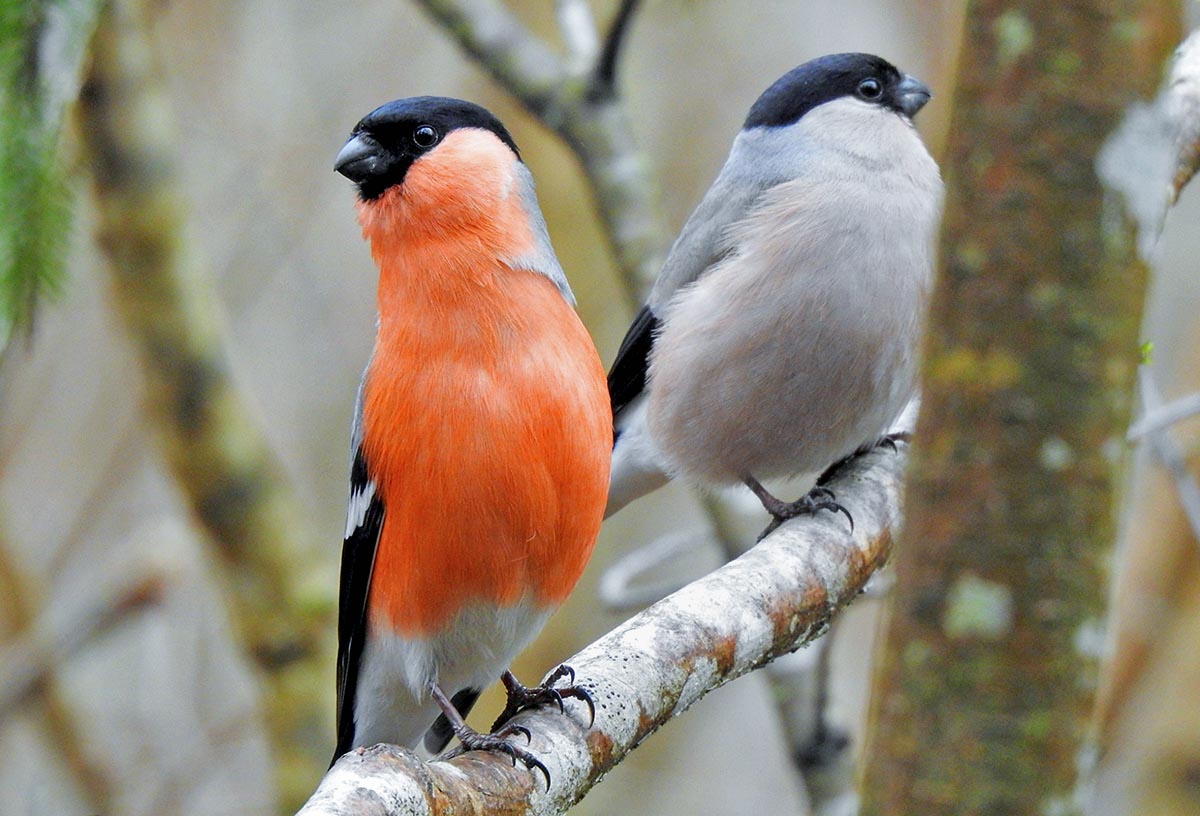
After courting, short but intense, they at once look for a place suitable for nesting hidden among the low fronds of the trees, often in nurseries of conifers © Eero Kiuru
The head has a very black hood that slightly goes down alo on the chin, amalgamating with the big beak, also pearly black.
The wings and the tail are black too with two alar white bars well visible when perched but even more when flying together a candid supra tail that renders it very easy in the identification.
The female is exactly the same as the male, but replacing the shocking pink colour with a delicate grey amber colour. The young have the livery fairly similar to the female but with a very haggard and poorly distinct black and grey shade. The pink colour of the male will appear only during the second year.
The subspecies classified for this species are several, with sometimes sensible variations of the plumage and of the size.
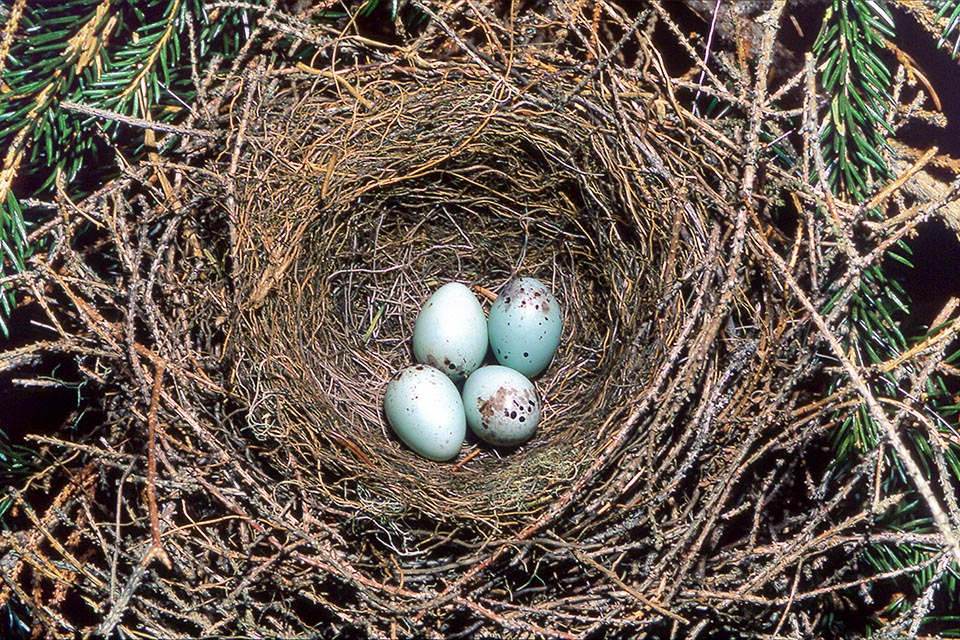
The nest is a quite ample and disorderly platform of small twigs, over which is formed a well defined and soft cup, lined with fluff, dry herbs, rootlets and some feathers where the female lays 4-5 bluish eggs that display the drawings particular to the finches. Two broods are usually laid per year, exceptionally three in favourable seasons © Museo Civico di Lentate sul Seveso
The Trumpeter bullfinch, the common name given to the north-European subspecies (Pyrrhula pyrrhula pyrrhula), has, for instance, a much brighter colour and much larger dimensions than the continental European holotype (Pyrrhula pyrrhula europaea), besides a call that seems the sound of a small trumpet.
This is the subspecies that often bursts in South Europe during the winter movements and is easily distinguishable on the field because of these sensible differences.
Among the main ones are Pyrrhula pyrrhula pileata of the British islands, Pyrrhula pyrrhula rossikowi of Anatolia and Caucasus, Pyrrhula pyrrhula caspica of Iran, Pyrrhula pyrrhula iberiae of the Iberian Peninsula, Pyrrhula pyrrhula cineracea of the Altai Mountains, Pyrrhula pyrrhula griseiventris of China up to Japan and Pyrrhula pyrrhula cassinii of Kamchatka and coasts of Okhotsk Sea.
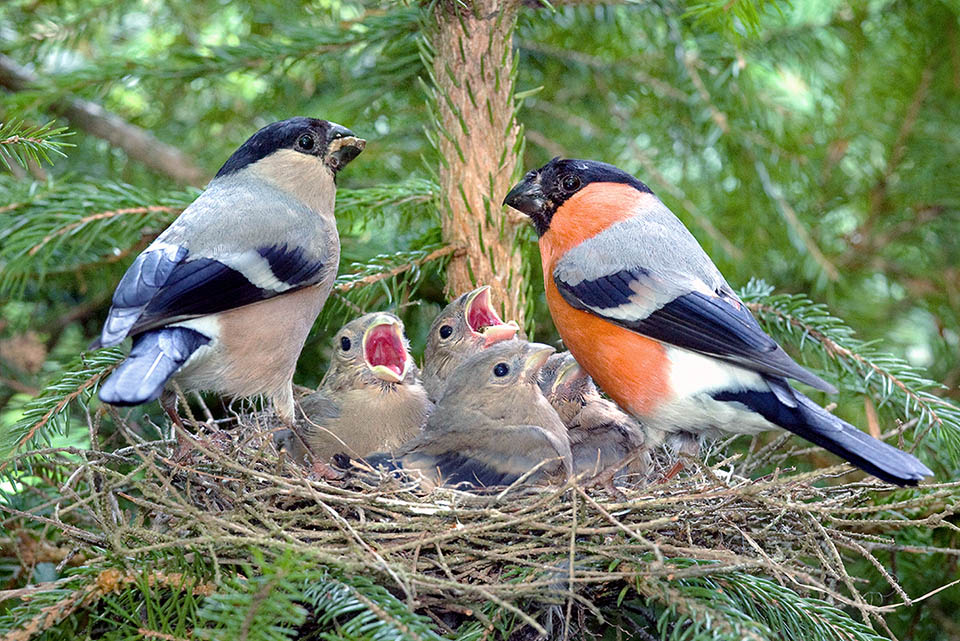
During nidification the parents are very faithful and very cohesive in the growth of the progeny, fed initially with insects and then with shredded and predigested grains © Jiri Bohdal
Ethology-Reproductive Biology
Though the Bullfinch is a bird frequenting the tall branches of the trees, it usually builds the nest at relatively much lower heights, between one and three metres and hides the nest on the thicker branches located at the base of the trees.
This choice has been favoured by the numerous nurseries of conifers scattered in the hill and mountain areas of Europe and that create those very dense and quiet thickets that are satisfying the requirements of a bird considered in turn as one of the most reluctant and shy within our finches.
The Bullfinch rarely gathers in groups even if few individuals, preferring always a solitary or coupled life, union that in any case lasts long even after nesting.
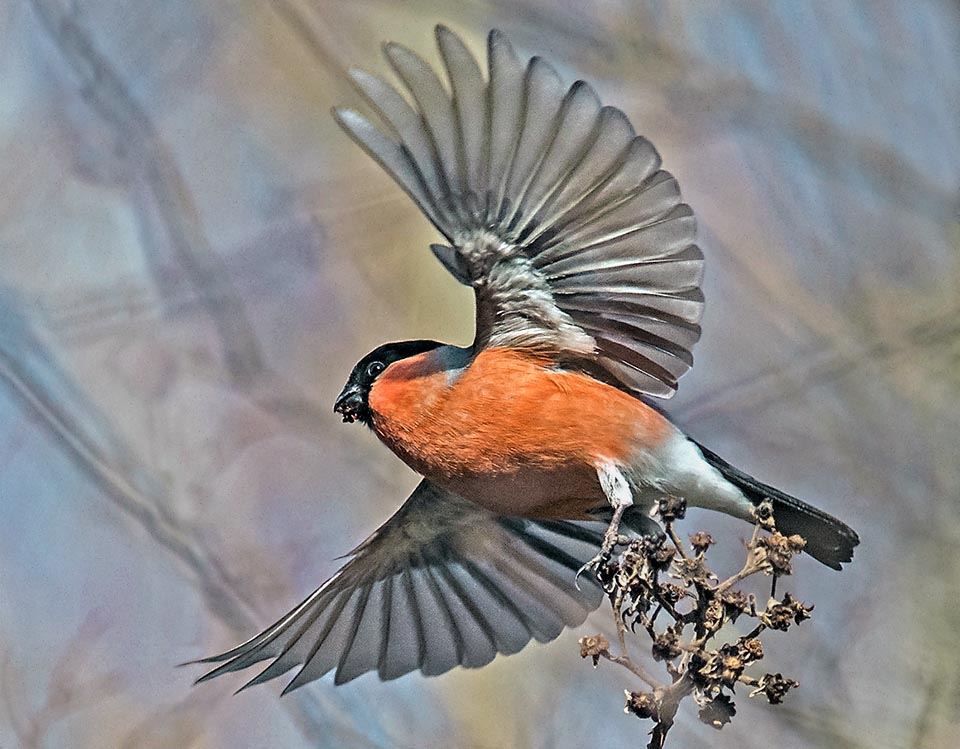
It’s an endless come and go from the nest. As the warm season comes the fruits of the shrubs are now ripe and the bullfinch eats them incessantly © Wayne Davies
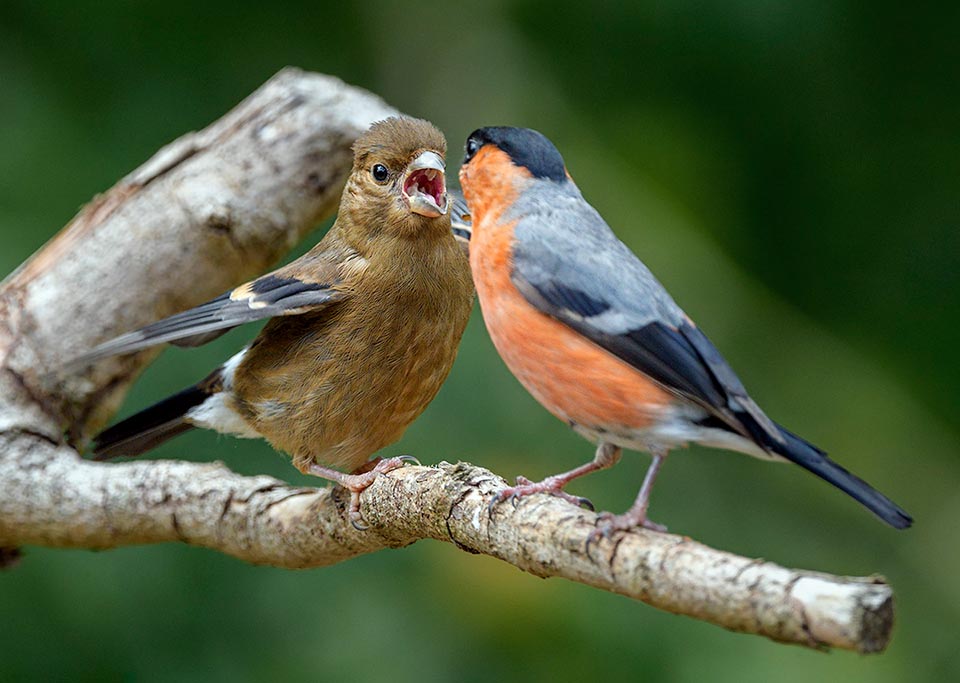
Here a hungry pullet, now older, runs to meet its father © Jerry Hawker
The nest is a rather ample and disorderly platform set of small twigs, above which is formed a cup well defined and soft, lined with fluff, dried herbs, rootlets and some feathers.
Are laid 4 or 5 eggs of bluish cream colour, sparsely speckled by small deep red and black spots, that are hatched by the female alone for about two weeks.
Upon the birth the progeny is attended by both partners for 15 days more.
Two broods are usually laid per year, exceptionally three in favourable seasons.
The chicks are nourished initially with caterpillars and other insects, replaced almost immediately by shredded and pre-digested grains.
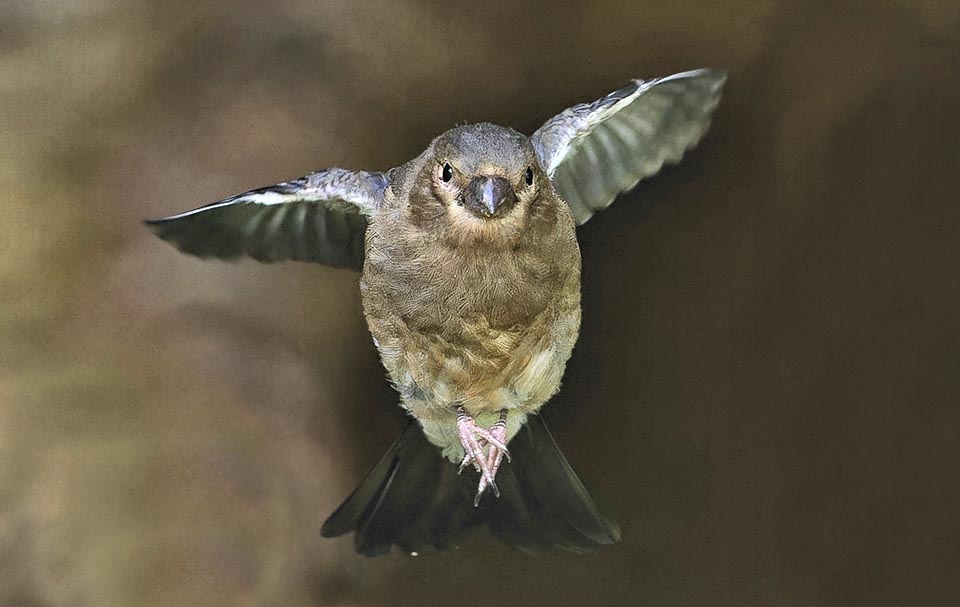
The kids learn early how to fly and even if followed initially by the parents, quickly take the way to the independence © Cornelis Bakker
The Bullfinch in fact is predominantly vegetarian with a love for oily and fat seeds such as beechnuts, samarae, pine and sunflowers seeds if available, but also berries of hawthorn and of dog rose that remain on the shrubs during the winter months, as well as apples and pomegranates.
It has been said of the particular confidence and ingenuity this bird displays in its ancestral behaviour, so much to be , by many, considered as a gullible and even dumb bird.
It is not easy to observe a Bullfinch in its natural environment. It keeps usually well among the fronds high on the trees and its presence is signaled only by continuous and mournful peeu it emits insistently.
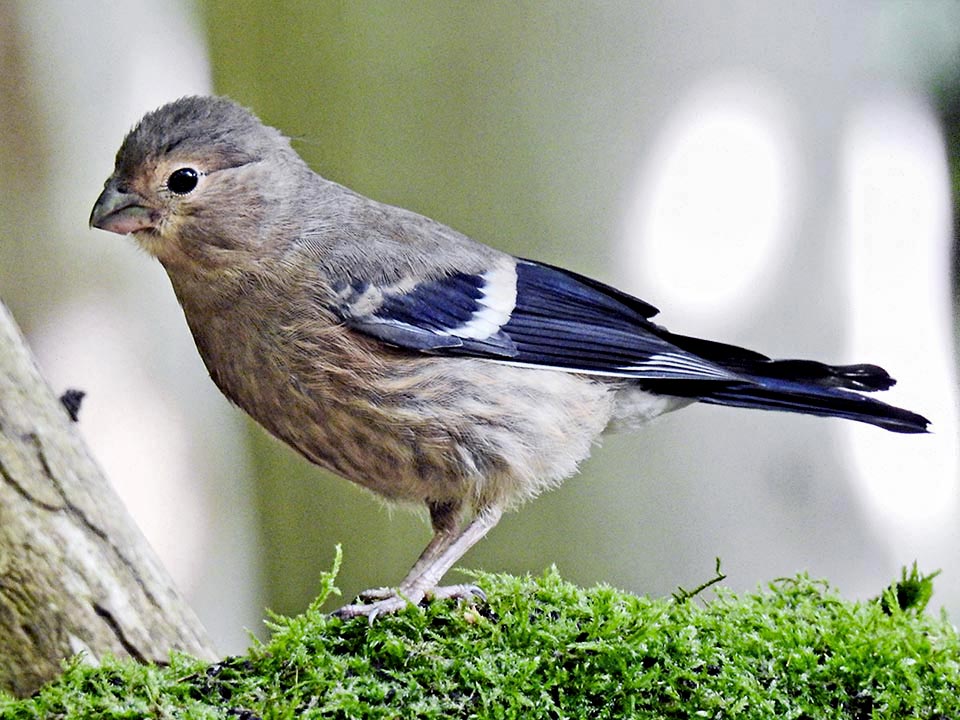
For some months they keep the juvenile livery, similar to the females’ one, assuming the adult one during the new year © Eero Kiuru
Well, upon the simple imitation of this mournful whistle, the Bullfinch immediately shows up to verify the source of this song and shows up in its beauty getting even a few metres from the whistler.
It is also said that the male of this species, in the couple relationship, is overwhelmed and overpowered by the supremacy of the female so there would be a ruthless submission between the sexes. It looks like that the male never dares to contradict its partner. A very common case among humans but maybe unique among the birds.
In the Red List of endangered species Pyrrhula pyrrhula is considered “Least Concern“.
Synonyms: Loxia pyrrhula Linnaeus, 1758.
→ To appreciate the biodiversity within PASSERIFORMES please click here.
